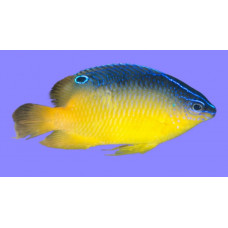Latin name
Pomacentrus milleri
Other name
Pomacentrus milleri
Identification
Pomacentrus: Greek, poma, -atos = cover, operculum + Greek, kentron = sting.
Miller's damselfish have an elongated body shape that is compressed at the sides. They have a broken lateral line and a nostril on each side. Flakes are of medium size.
Features of fish fins
Dorsal spines (total): 13 - 14; Dorsal soft rays (total): 13 - 14; Anal spines: 2; Anal soft rays: 13 - 14.
Fish colouring
The body of the Miller's damselfish has vivid yellow and blue tones.
Distribution
Widespread in the eastern Indian Ocean: Northern Australia, from Rottnest Island (near Perth) to Arnhem Land, Northern Territory.
Habitat
Tropical marine, reef associated species. Habitat depth from 1 to 6 m.
Size
Males of this species reach a maximum length of 7.5 cm.
Behavior
A diurnal species. Adults live in coastal reef areas, usually on dead coral, and do not migrate.
Food and feeding habits
Miller's damselfish feed on algae, plankton and small bottom-dwelling crustaceans.
Reproduction
Egg-laying, mating during reproduction. Eggs are on the bottom and adhere to the substrate. Males guard and aerate eggs.
Fishing
This species is not commercially important.
Relationship with a person
Harmless.
| Classification | |
| Phylum | Chordata |
| Class | Actinopterygii |
| Squad | Perciformes |
| Family | Pomacentridae |
| Genus | Pomacentrus |
| Species | P. milleri |
| Features | |
| Conservation status | Least Concern |
| Habitat | Pelagic |
| Life span, years | No information |
| Maximum body weight, kg | No information |
| Maximum length, cm | 7,5 |
| Sailing speed, m/s | No information |
| Threat to people | Edible |
| Way of eating | Planktonophage |
Miller's damselfish
Tags: miller's damselfish

